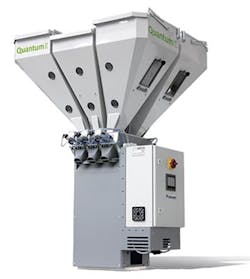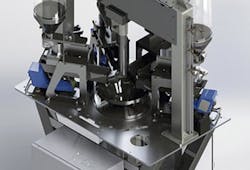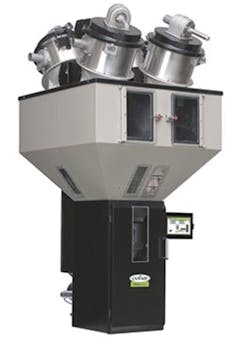Materials Handling: Blending equipment gets smarter, faster, more accurate
When developing or upgrading their blending equipment, companies can implement new technology in a variety of ways. Some focus on enabling machines to communicate with each other on the road to a Smart Factory, while others work to improve processing speed and dosing accuracy. Still others emphasize the human element, striving to find ways that make their equipment easier to use and maintain.
All of those improvements and more have been implemented within the last year by some of the industry's top blending equipment manufacturers.
Una-Dyn
First shown at the K show, the latest gravimetric batch blender and dosing system from Piovan SpA recently became available worldwide. The Quantum E blender, which was developed by the Santa Maria di Sala, Italy-based company and is distributed in the U.S. by Universal Dynamics, was designed for monoextrusion and coextrusion of film and provides gravimetric blending of up to eight ingredients. It features double load cells for maximum dosing accuracy, has a modular design that allows dosing stations to be added or replaced easily, and conveys resin without mechanical stress or the risk of crushing the pellets.
The blender also provides the benefits of both gravimetric and loss-in-weight systems. "Typically, blenders are either gravimetric batch or loss-in-weight," said Giorgio Santella, VP of North American sales and service. "Quantum E combines those two technologies, offering both the gravimetric batch blender's simplicity of design and the process control of a loss-in-weight continuous blender."
The blender also can track each ingredient and precisely determine the amount of material used in each lot. The Quantum E's controller allows the user to monitor the materials by batch as well, guaranteeing the materials' traceability.
Piovan's engineers spent considerable time and effort on the design of the new stainless-steel, hemispherical mixer unit, which is now being offered on all Piovan gravimetric blenders.
"A very important element of value when evaluating the design of a blender mixer is the capability of homogenization of the blend," Santella said. "The accuracy of ingredient proportions can be totally compromised if the mixer cannot adequately [combine] those ingredients into a homogeneous blend."
To achieve that, designers gave the Quantum E a level sensor that does not require any calibration and never loses sensitivity, regardless of whether the materials have different geometries, dimensions or densities. Static charges and the presence of powder do not affect the sensor's operation.
Finally, the system's load cells are equipped with an automated cleaning system that operates after each cycle, and the discharge system allows the entire hopper to be emptied, leaving no residue.
Advanced Blending Solutions
After customers expressed the need to address one of their biggest pain points — high labor costs — Advanced Blending Solutions (ABS) developed its first fully automated clean-out system for blenders, the Chameleon Simplicity 3000, and brought it to market in May.
Available on new blenders, the system can be retrofitted on existing units. It can complete a material change with no human intervention — and in as little as 20 seconds, depending on the size of the blender.
First, an automated vacuum system removes material from the feeder tray and sends it to a material-collection station for later use, and then the sidewalls of the hopper are cleaned with compressed air.
In addition to saving on labor costs, ABS says the Chameleon reduces both downtime and purge waste, and its throughput can be sized according to specific customer needs.
When customers need help, an increasing number of companies like ABS are willing to work directly with them to ensure the equipment they buy is exactly what they need. If a customer will be running an additive or regrind that has nonstandard characteristics, for example, ABS encourages the client to send in a sample for testing.
"More and more, our customers are looking for unique, catered solutions that provide strategic competitive advantages to them to reduce their cost to produce their end product," said Dan Haas, VP of engineering. "Our engineers work directly with the customers as an extension of their engineering departments to better understand the facilities, products and applications to help integration efforts as much as possible," he said.
Conair
When it comes to making the best possible blender, nothing is more important than accuracy, said Alan Landers, blender product manager for Conair. That's why the company's TrueBlend gravimetric blenders for injection molding and extrusion now feature the new SmartBlend SB-3 control, which made its debut in May.
"Dosing accuracy is based on a 'feed-forward' learning algorithm," Landers said. "Instead of making a single dispense of each ingredient and adjusting for errors in subsequent batches, the SB-3 uses incremental dispenses in each batch, continuously weighing the material and adding a little bit more until the target weight is reached." Conair says the new SB-3's approach ensures that dosing is accurate to within 0.025 percent.
In the original SmartBlend design, the dispensing order began with regrind, then resin, and then the color or additive. The color/additive was normally handled last so it could be calculated to the proper percentage of the already-weighed resin.
"However, this could prove problematic when the amount called for was merely a few pellets, or even a fraction thereof," Landers said. "If the amount of natural material weighed would normally require adding 7.5 pellets, the blender could only dispense either seven or eight pellets, resulting in an accuracy of only plus or minus 6 percent."
To address the issue, Conair set up the SB-3 to default to its Precision Additive mode. "In Precision Additive mode, the minor ingredient is dispensed second, and weighed as accurately as possible, and then the natural is adjusted accordingly for any variation of this critical ingredient. Accuracy is increased dramatically without having to split pellets," Landers said.
The SB-3's 7-inch display supports 16 languages and can store 3,000 recipes and 4,000 resin names. It also includes a self-loading option in which users can mount vacuum receivers to the blender hoppers, then use the touch screen to control up to 12 loaders and one pump for conveying to or from the blender.
Michael T. McCue, copy editor
For more information
Advanced Blending Solutions LLC,Wallace, Mich., 906-914-4180, www.adv-blend.com
Conair Group,Cranberry Township, Pa., 724-584-5500, www.conairgroup.com
Universal Dynamics Inc.,Woodbridge, Va., 703-490-7000, www.piovan.com




